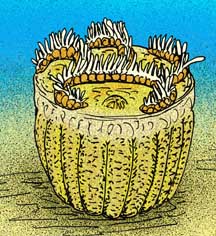Camptostroma
| Camptostroma Temporal range: Early Cambrian
| |
|---|---|

| |
| Artist's reconstruction | |
| Scientific classification | |
| Kingdom: | |
| Phylum: | |
| Class: | |
| Genus: | †Camptostroma
|
| Species: | †C. roddyi
|
| Binomial name | |
| Camptostroma roddyi Ruedemann 1933[1]
| |
Camptostroma roddyi is an extinct echinoderm from the Bonnia-Olenellus Zone of the Early Cambrian Kinzers Formation near York and Lancaster, Southeastern Pennsylvania.[2] It is the only known species in the genus Camptostroma, as other species referred to this genus "do not appear to be cogeneric."[3]
Anatomy
[edit]In life, Camptostroma would have resembled a cupcake, with the mouth in the center of the upper surface, with ambulacra radiating from it in the 2-1-2 pattern common in early echinoderms. The ambulacra are straight in juveniles, but in larger adult specimens, ambulacra A, B, C, and E curve clockwise while ambulacrum D curves counter-clockwise. The anus is near the periphery between ambulacra C and D.[4]
The ambulacra may have extended beyond the upper surface on stubby arms. While this diagnosis is tentative, ongoing work appears to support it.[5]
Classification and relationships
[edit]
While initially considered to be a scyphozoan due to the fossil's medusoid shape, later investigation detected the presence of stereom plates with the calcitic cleavage pattern diagnostic of echinoderms.[2]
The Treatise on Invertebrate Paleontology accepted Durham's 1966 assigment of Camptostroma to its own class, Camptostromatoidea.[6] However, a later revision of the Treatise's classification omitted this class.[7]
Camptostroma has since been placed in a class of basal echinoderms, the Edrioasteroids,[8] although some recent authors only describe it as "edrioasteroid-like".[5]
Recent research has found weak support for the recovery of Camptostroma as the sister group of the crinoids.[9][10] However, other phylogenies are ambiguous regarding whether it is closer to the crinoids, eocrinoids, or eleutherozoans.[11]
References
[edit]- ^ "Camptostroma roddyi". The Paleontology Database. Retrieved November 3, 2024.
- ^ a b Durham 1966
- ^ Durham 1967, p. S629
- ^ Paul & Smith 1984, pp. 450–452
- ^ a b Guensburg, Mooi & Mongiardino Koch 2023, p. 1097
- ^ Durham 1967
- ^ Sprinkle 1980, p. 26
- ^ Zamora et al. 2017, p. 484
- ^ Guensburg et al. 2020, p. 332
- ^ Guensburg, Mooi & Mongiardino Koch 2023, pp. 1104–1106
- ^ Rahman & Zamora 2024, pp. 310–311
Works cited
[edit]- Durham, J. W. (1 September 1966). "Camptostroma, an Early Cambrian Supposed Scyphozoan, Referable to Echinodermata". Journal of Paleontology. 40 (5): 1009–1255. ISSN 0022-3360. JSTOR 1301996.
- Durham, J. Wyatt (1967). "Addendum: Camptostromatoids". In Moore, Raymond C. (ed.). Treatise on Invertebrate Paleontology, Part S: Echinodermata 1. Vol. 1. University of Kansas Press. pp. S627 – S631. Retrieved 29 October 2024.
- Guensburg, Thomas E.; Mooi, Rich; Mongiardino Koch, Nicolás (2023). "Crinoid calyx origin from stem radial echinoderms". Journal of Paleontology. 97 (5): 1092–1115. doi:10.1017/jpa.2023.14.
- Guensburg, Thomas E.; Sprinkle, James; Mooi, Rich; Lefebvre, Bertrand; David, Bruno; Roux, Michael; Derstler, Kraig (2020). "Athenacrinus n. gen. and other early echinoderm taxa inform crinoid origin and arm evolution". Journal of Paleontology. 94 (2): 311–333. doi:10.1017/jpa.2019.87.
- Paul, C. R. C.; Smith, A. B. (November 1984). "The early radiation and phylogeny of echinoderms". Biological Reviews. 59 (4): 443–481. doi:10.1111/j.1469-185X.1984.tb00411.x.
- Rahman, Imran A.; Zamora, Samuel (July 2024). "Origin and early evolution of echinoderms". Annual Review of Earth and Planetary Sciences. 52: 295–320. doi:10.1146/annurev-earth-031621-113343. hdl:10141/623070.
- Sprinkle, J. (1980). "An Overview of the Fossil Record". Notes for a Short Course: Studies in Geology. 3: 15–26. doi:10.1017/S0271164800000063.
- Zamora, Samuel; Deline, Bradley; Álvaro, J. Javier; Rahman, Imran A. (2017). "The Cambrian Substrate Revolution and the early evolution of attachment in suspension-feeding echinoderms". Earth-Science Reviews. 171: 478–491. doi:10.1016/j.earscirev.2017.06.018.
